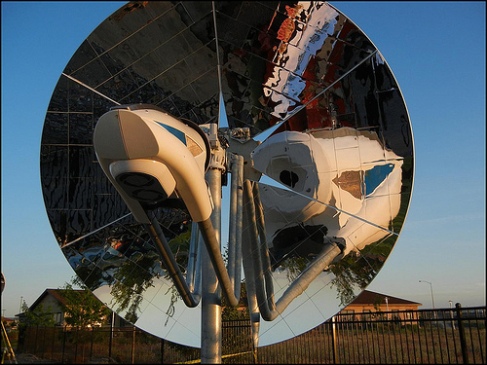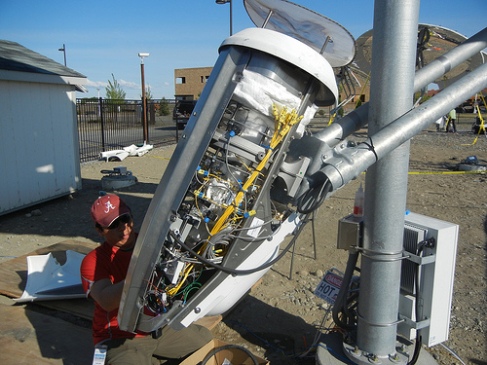In the 1800s, British economist Thomas Malthus birthed the notion of “The Self-Extinction Premise”- a hypothesis ahead of its time that is now drifting (or perhaps more accurately, hurling) into the very immediate realm of possibilities for those of us currently inhabiting this spaceship known as Earth. The Self-Extinction Premise determines that the human population will eventually exhaust all available resources; essentially, we will be the reason we are extinct one day. (*Note: This is not a phenomenon that occurs in nature – it is distinctly unique to us as a species. This is not “good”…) We have seen this premise fulfilled in civilizations such as the Mayans and that of Easter Island, and many involved with &/or aware of the current state of affairs admit it might not be too far off for us.
“Necessity is the mother of invention.” The necessity of our time is for a dramatic shift from the so aptly-deemed “fossil fuels”, to a cleaner energy source. This necessity has birthed alternative energy sources that focus and rely heavily on renewable resources such as wind, sun, and water. This shift has been slower to pick up than most of its enthusiasts might prefer, but its proponents eagerly & willingly bear the burden of coaxing the world up & out of its slumber, and into a new, more aware, mindful, & regenerative paradigm. These enthusiasts, in accordance with human nature, tend to also carry with them quite strong opinions regarding the superiority of these technologies. As these industries expand, we begin to see what they are capable of- which, as it turns out, isn’t all “good”.
In 2011, Chinese authorities ordered the shutdown of solar panel manufacturing plant Jinko Solar after days-long protests powered by over 500 residents of the surrounding area. These residents were the witnesses to the dirtier side of this “clean” energy industry – claiming pollution from the plant as the cause of contaminated water, poisoned pigs, & dead fish. Tests went on to reveal that the plant was responsible for high amounts of fluoride and had been failing pollution tests for nearly six months prior.

Chinese villagers protest Jinko Solar Plant pollution
As the world wakes, it becomes aware of all aspects of all sides – even, and perhaps now especially, the shadows of what has been highly glorified as a “pure” industry. In economics, we acknowledge the existence of the first-best scenario (ideal) and the second-best (reality). As one could determine from the former sentence, the second-best scenario is more often the reality of a situation. In my eyes, the ideal, or first-best, scenario in the energy realms would allow for us to use a totally “clean” renewable resource to the end of our lifetimes, while providing for generations to come. This resource would be pure and free of any adverse effects manifest in the form of pollution or cost. This scenario can be interpreted subjectively, however, which brings us to the current second-best scenario. We must realize that some players in this game currently benefit from “dirtier” sources of energy, hence resistance and a slower shift beyond these dinosaur technologies. In regard to Jinko’s particular situation, the lax regulations that allowed this pollution the first place have allowed consumers to benefit from lower costs on solar panels. With stiffer regulations, manufacturing costs are likely to increase, which will reverberate out through every part of the process, landing with the consumer.
More recently, in February of this year, the Associated Press wrote a report regarding the sludge and wastewaster products of the solar industry:
“While solar is a far less polluting energy source than coal or natural gas, many panel makers are nevertheless grappling with a hazardous waste problem. Fueled partly by billions in government incentives, the industry is creating millions of solar panels each year and, in the process, millions of pounds of polluted sludge and contaminated water.
To dispose of the material, the companies must transport it by truck or rail far from their own plants to waste facilities hundreds and, in some cases, thousands of miles away.
The fossil fuels used to transport that waste, experts say, is not typically considered in calculating solar’s carbon footprint, giving scientists and consumers who use the measurement to gauge a product’s impact on global warming the impression that solar is cleaner than it is.”
Grist came in with a follow-up article noting that the 11 million pounds of sludge and wastewater/year of the solar industry might be better understood in comparison with the 584 trillion pounds of waste/year that comes of the fracking industry. AP also noted that pollution in the solar industry might be unusually high because of the industry’s rapid growth. AP’s editorial concluded with the recognition of the lifespan of solar panels as another redeeming factor in its efforts to lead the green, clean revolution.

In the editorial “No Such Thing as Free Energy”, the Times Colonist addresses the less-obvious, and thus often ignored, consequences of what is commonly pronounced “clean” or “free” energy:
“The easiest way to solve the energy dilemma is to use less of it. We have become energy spendthrifts, lavishly lighting our homes, public places and streets. We drive more than we need to.
We spend too much heating and cooling buildings, when relatively inexpensive design changes could significantly reduce energy consumption. Homes built to R2000 standards, says Natural Resources Canada, will add two to four per cent to construction costs, but will use 30 per cent less energy than conventional homes.
Simply siting a house to take advantage of the sun’s position can bring measurable energy savings, as can the judicious use of trees, shrubbery and other landscaping.
Energy research holds much promise, but we shouldn’t count on future technological advances to continue supporting our wasteful energy habits when there’s so much we can be doing in the present.”
This prescription nails it on the head for me. It is important to see all sides of the situation, as I have begun to touch upon. This does not mean, however, that we may simply compare solar to coal and call it a day. It also does not mean that we abandon the quest for betterment due to this one discrepancy. The Times Colonist truly articulates the responsibility of our times – to be more mindful. The responsibility, in this day and age more than possibly ever before, lies with the individual, to “be the change” – because this is one shift we can choose the acceleration rate of.


Works Cited
Bump, Philip. “Are Solar Panels the Worst Thing for the Environment Ever? Um, No.” Grist. N.p., 11 Feb. 2013. Web. 20 Apr. 2013.
Dearen, Jason. “Solar Energy: Dirtier Than We Think.” Ideas Changing the World. National Center for Policy Analysis, 14 Feb. 2013. Web. 20 Apr. 2013.
“No Such Thing as Free Energy.” Times Colonist. N.p., 24 Apr. 2013. Web. 24 Apr. 2013.
Vranicar, David. “Chinese Solar Panel Plant Shut down Due to Pollution, Protests.” The Earth Times. N.p., 22 Sept. 2011. Web. 20 Apr. 2013.http://www.nytimes.com/2011/09/20/world/asia/china-shuts-solar-panel-factory-after-anti-pollution-protests.html?_r=0














 The conclusion drawn from analyzing the Ricardian model’s results was that “households with climate change adaptation measures tended to produce about 87 kg more of food per hectare than those who did not take such measures.” Those who did not take adaptation measures choose to do so due to lack of information, lack of money and credit, and lack of labor.” The results suggest that when these farmers have access to accurate information about irrigation and climate change, along with access to institutional support, including credit, they are more likely to adapt- and therefore more likely to experience net gains in productivity and revenue.
The conclusion drawn from analyzing the Ricardian model’s results was that “households with climate change adaptation measures tended to produce about 87 kg more of food per hectare than those who did not take such measures.” Those who did not take adaptation measures choose to do so due to lack of information, lack of money and credit, and lack of labor.” The results suggest that when these farmers have access to accurate information about irrigation and climate change, along with access to institutional support, including credit, they are more likely to adapt- and therefore more likely to experience net gains in productivity and revenue.  Overall, the conclusion of this article points out that adaptations combined with the shifting climate may actually have a net positive impact on agriculture in Nigeria if the government can come through with policies that support education, institutional support, and conservation methods (i.e. organic farming strategies) for the farmers. In a nation so dependent on agriculture for livelihood, there is perhaps no other choice. As we have discussed in class, lands can be evaluated for categories of use by different evaluation models. This article demonstrates the ability for Nigerian farmers to manipulate the use value of their land by adapting to climate change.
Overall, the conclusion of this article points out that adaptations combined with the shifting climate may actually have a net positive impact on agriculture in Nigeria if the government can come through with policies that support education, institutional support, and conservation methods (i.e. organic farming strategies) for the farmers. In a nation so dependent on agriculture for livelihood, there is perhaps no other choice. As we have discussed in class, lands can be evaluated for categories of use by different evaluation models. This article demonstrates the ability for Nigerian farmers to manipulate the use value of their land by adapting to climate change.